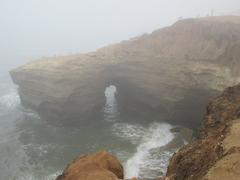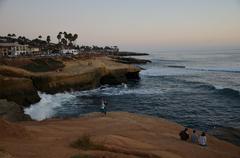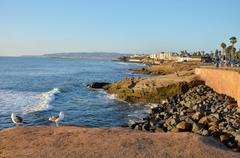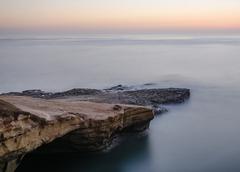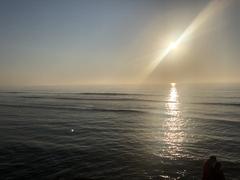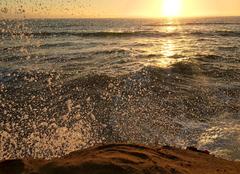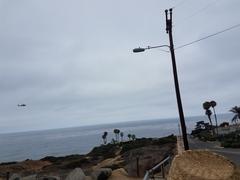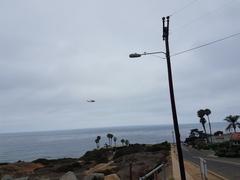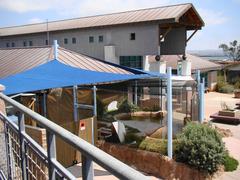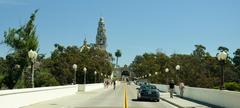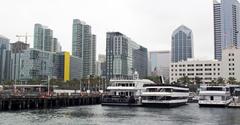
Visiting Sunset Cliffs: Your Ultimate Guide to San Diego’s Coastal Gem
Publication Date: 19/07/2024
Introduction to Sunset Cliffs
Sunset Cliffs, located along the Point Loma peninsula in San Diego, California, is a pristine coastal landmark that captures the essence of natural beauty and historical significance. This iconic destination offers visitors breathtaking ocean views, unique geological formations, and a rich tapestry of history dating back thousands of years. From the early days of the Kumeyaay people to the arrival of European explorers, Sunset Cliffs has been a site of cultural and ecological importance. Today, it stands as a beloved public park, drawing nature enthusiasts, photographers, surfers, and tourists from around the world.
The cliffs are not only a natural wonder but also a sanctuary for diverse marine life and bird species. Visitors can explore tide pools teeming with sea anemones, starfish, and crabs, or spot peregrine falcons nesting in the rocky outcrops. The park’s intricate trails provide panoramic views of the Pacific Ocean, making it an ideal spot for hiking, meditation, and witnessing some of the most stunning sunsets in Southern California. This guide aims to provide a comprehensive overview of Sunset Cliffs, including its history, ecological significance, visitor tips, and activities to ensure a memorable experience.
Contents Overview
- Introduction
- Early History and Indigenous Significance
- European Exploration and Settlement
- Development in the 19th and 20th Centuries
- Establishment as a Public Park
- Visiting Hours and Ticket Information
- Geological Significance
- Ecological Importance
- Cultural and Recreational Significance
- Travel Tips and Accessibility
- Conservation Efforts
- FAQ
- Attractions and Activities at Sunset Cliffs, San Diego
- Sunset Cliffs Natural Park
- Surfing and Water Activities
- Sunset Viewing
- Hiking and Walking Trails
- Point Loma Nazarene University
- Whale Watching
- Yoga and Meditation
- Photography
- Local Flora and Fauna
- Safety and Accessibility
- Nearby Attractions
- Environmental Considerations
- Local Regulations
- Weather Considerations
- Photography Tips
- Conclusion
Exploring Sunset Cliffs, San Diego - History, Visiting Hours, and Travel Tips
Early History and Indigenous Significance
Sunset Cliffs has a history that spans thousands of years, initially inhabited by the Kumeyaay people, who have lived in the region for over 12,000 years. The Kumeyaay utilized the coastal resources for fishing, gathering shellfish, and other marine activities. The cliffs provided a strategic vantage point for observing marine life and incoming weather patterns, crucial for their survival and cultural practices.
European Exploration and Settlement
The first recorded European contact with the area was by the Portuguese explorer Juan Rodríguez Cabrillo in 1542. Cabrillo’s expedition marked the beginning of European interest in the region, eventually leading to Spanish colonization. The Spanish established the Presidio and Mission San Diego de Alcalá in 1769, becoming the first European settlement in what is now California. The cliffs were part of the land granted to the mission and were used for grazing livestock and other agricultural activities.
Development in the 19th and 20th Centuries
In the 19th century, the land around Sunset Cliffs began to be developed for residential and recreational purposes. The area saw significant changes with the arrival of developers like Albert Spalding, who envisioned a scenic residential community. In the early 20th century, the cliffs became a popular destination for locals and tourists alike, drawn by the stunning ocean views and natural beauty.
Establishment as a Public Park
In 1925, the City of San Diego acquired the land that would become Sunset Cliffs Natural Park. The park was established to preserve the natural beauty of the area and provide public access to the coastline. Over the years, the park has been expanded and improved, with efforts to restore native vegetation and protect the fragile coastal environment.
Visiting Hours and Ticket Information
Sunset Cliffs Natural Park is open daily from 6:00 AM to 10:00 PM. There is no admission fee to visit the park, making it an accessible destination for everyone. For up-to-date information on any special events or temporary closures, please visit the official website.
Geological Significance
Sunset Cliffs is renowned for its unique geological formations, the result of millions of years of natural processes. The cliffs are composed primarily of sedimentary rock, including sandstone and shale, deposited during the Eocene epoch, approximately 40 to 50 million years ago. The constant action of waves and wind has sculpted the cliffs into their current dramatic shapes, creating sea caves, arches, and other features that attract geologists and nature enthusiasts.
Ecological Importance
The cliffs and surrounding areas are home to a diverse array of plant and animal species. The intertidal zones are rich with marine life, including tidepool creatures such as sea anemones, starfish, and crabs. The cliffs themselves support a variety of bird species, including peregrine falcons, which nest in the rocky outcrops. Efforts to preserve and restore the native vegetation have helped to maintain the ecological balance of the area.
Cultural and Recreational Significance
Sunset Cliffs has long been a cultural and recreational landmark in San Diego. The area is a popular spot for surfing, with several well-known surf breaks along the coastline. The cliffs also offer numerous hiking trails, providing visitors with opportunities to explore the natural beauty of the area. The park is a favorite location for photographers and artists, drawn by the stunning sunsets and dramatic coastal scenery.
Travel Tips and Accessibility
For those planning a visit, here are some helpful tips:
- Parking: Limited parking is available near the park entrances. Arrive early to secure a spot, especially on weekends.
- Accessibility: While some trails are accessible, the rugged terrain can be challenging. Wear appropriate footwear and be cautious around cliff edges.
- Nearby Attractions: The Point Loma Lighthouse and Cabrillo National Monument are nearby and offer additional historical and scenic experiences.
- Guided Tours: Check the San Diego History Center for information on guided tours that provide deeper insights into the area’s history and significance.
Conservation Efforts
In recent years, there have been ongoing efforts to protect and preserve Sunset Cliffs from the impacts of urbanization and climate change. The Sunset Cliffs Natural Park Council, a volunteer organization, works in partnership with the City of San Diego to manage and maintain the park. Projects have included erosion control measures, habitat restoration, and public education programs to promote environmental stewardship.
Attractions and Activities at Sunset Cliffs, San Diego
Sunset Cliffs Natural Park
Sunset Cliffs Natural Park is a 68-acre resource-based park stretching along the Pacific Ocean, offering breathtaking views and a variety of activities. The park is renowned for its dramatic cliff formations, coastal bluffs, and panoramic ocean vistas. Visitors can enjoy walking along the trails that wind through the park, providing numerous vantage points for photography and sightseeing. The park is also a popular spot for bird watching, with many species of seabirds frequenting the area.
Surfing and Water Activities
The rugged coastline of Sunset Cliffs is a haven for surfers. The waves here are known for their consistency and quality, attracting surfers of all skill levels. The most popular surf spots include Luscomb’s Point and Garbage Beach. It’s important to note that the surf can be challenging, with strong currents and rocky reefs, so it’s recommended for experienced surfers. For those who prefer less intense water activities, tide pooling is a fascinating way to explore the marine life in the area. The low tide reveals a variety of sea creatures, including starfish, sea anemones, and crabs.
Sunset Viewing
As the name suggests, Sunset Cliffs is one of the best places in San Diego to watch the sunset. The cliffs provide an unobstructed view of the horizon, making it a perfect spot for a romantic evening or a peaceful moment of reflection. Many visitors bring blankets and picnic baskets to enjoy the sunset from the comfort of the grassy areas or the benches scattered throughout the park. The golden hour at Sunset Cliffs is a photographer’s dream, with the changing light creating stunning effects on the ocean and cliffs.
Hiking and Walking Trails
Sunset Cliffs offers several hiking and walking trails that cater to different fitness levels. The main trail runs along the edge of the cliffs, providing spectacular views of the ocean and the rugged coastline. This trail is relatively easy and suitable for families with children. For those looking for a more challenging hike, the trails that descend to the beach areas offer a more strenuous workout. These trails can be steep and rocky, so proper footwear is recommended. Along the way, hikers can enjoy the natural beauty of the coastal vegetation and the sound of the waves crashing against the cliffs.
Point Loma Nazarene University
Located adjacent to Sunset Cliffs, Point Loma Nazarene University (PLNU) offers additional attractions for visitors. The university’s campus is known for its beautiful architecture and well-maintained gardens. Visitors can take a leisurely stroll through the campus and enjoy the serene environment. The university also hosts various cultural and educational events throughout the year, which are open to the public. These events include art exhibitions, musical performances, and lectures, providing a rich cultural experience for visitors.
Whale Watching
Sunset Cliffs is an excellent location for whale watching, especially during the migration seasons. From December to April, gray whales can be seen migrating south to the warm waters of Baja California. During this time, visitors can often spot these majestic creatures from the cliffs. Binoculars are recommended for a better view, and there are several lookout points along the cliffs that provide ideal vantage points for whale watching. In addition to gray whales, visitors may also see dolphins, sea lions, and other marine life.
Yoga and Meditation
The tranquil environment of Sunset Cliffs makes it an ideal location for yoga and meditation. Many local yoga instructors offer classes on the cliffs, allowing participants to practice their poses while enjoying the natural beauty of the surroundings. The sound of the ocean and the fresh sea breeze create a calming atmosphere, perfect for relaxation and mindfulness. For those who prefer a more solitary experience, the grassy areas and secluded spots along the cliffs provide a peaceful setting for personal meditation.
Photography
Sunset Cliffs is a paradise for photographers. The dramatic landscapes, vibrant sunsets, and diverse wildlife offer endless opportunities for capturing stunning images. Whether you’re a professional photographer or an amateur enthusiast, you’ll find plenty of inspiration at Sunset Cliffs. The golden hour, just before sunset, is particularly popular for photography, as the warm light enhances the natural beauty of the cliffs and ocean. Many photographers also enjoy capturing the dynamic waves and the unique rock formations that characterize the area.
Local Flora and Fauna
The natural park is home to a variety of native plants and animals. The coastal sage scrub habitat supports a range of plant species, including California sagebrush, buckwheat, and lemonade berry. These plants provide food and shelter for local wildlife, such as rabbits, lizards, and a variety of bird species. Bird watchers can spot species like the California gnatcatcher, peregrine falcon, and various seabirds. The diverse ecosystem of Sunset Cliffs offers a unique opportunity to observe and appreciate the natural beauty of Southern California.
Safety and Accessibility
While Sunset Cliffs offers many attractions and activities, it’s important to prioritize safety. The cliffs can be unstable in some areas, and there have been incidents of people falling. Visitors should stay on designated trails and avoid getting too close to the edge. Proper footwear is recommended, especially for those hiking down to the beach areas. Additionally, the park has limited accessibility for individuals with mobility issues, as many of the trails are uneven and steep. However, there are some paved areas and lookout points that are more accessible.
Travel Tips and Nearby Attractions
To make the most of your visit to Sunset Cliffs, consider these travel tips:
- Visit during the weekdays to avoid crowds.
- Check the tide schedule for the best tide pooling experience.
- Bring binoculars for bird watching and whale watching.
- Wear sturdy shoes for hiking the trails.
Nearby attractions include Cabrillo National Monument, Ocean Beach, and the Liberty Station, offering additional historical and recreational experiences.
FAQ
Q: What are the visiting hours for Sunset Cliffs?
A: Sunset Cliffs Natural Park is open from sunrise to sunset.
Q: Do I need to buy tickets to visit Sunset Cliffs?
A: No, visiting Sunset Cliffs is free of charge.
Q: Is Sunset Cliffs accessible for individuals with mobility issues?
A: The park has limited accessibility as many trails are uneven and steep. However, there are some paved areas and lookout points that are more accessible.
Q: Can I bring my dog to Sunset Cliffs?
A: Yes, dogs are allowed but must be kept on a leash.
Final Thoughts on Sunset Cliffs
Sunset Cliffs in San Diego remains an enduring symbol of natural beauty and historical significance. From its early days as a vital resource for the Kumeyaay people to its development as a public park, the cliffs have continued to captivate those who visit. The park’s geological formations, diverse ecosystems, and recreational opportunities make it a treasure trove for nature lovers and history buffs alike (San Diego History Center, Sunset Cliffs Natural Park Council).
Efforts to preserve and protect Sunset Cliffs are ongoing, ensuring that future generations can enjoy this magnificent coastal landmark. Whether you are hiking along the trails, exploring the tide pools, or simply watching the sunset, Sunset Cliffs offers a serene and inspiring experience. By following the provided travel tips and safety guidelines, visitors can make the most of their visit while contributing to the conservation of this cherished site. For more information and updates, be sure to follow the latest news and events, and consider exploring nearby attractions such as the Point Loma Lighthouse and Cabrillo National Monument.




